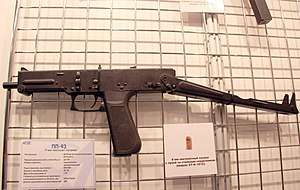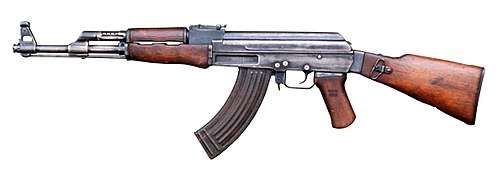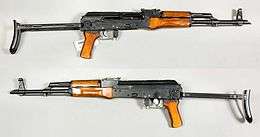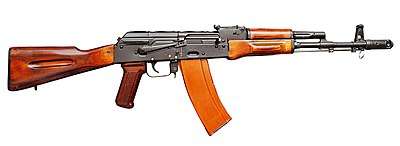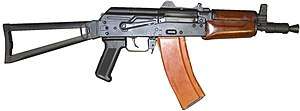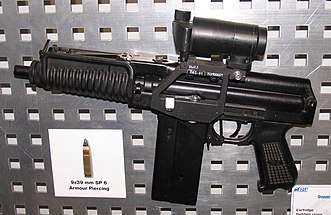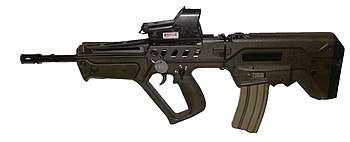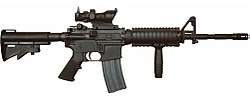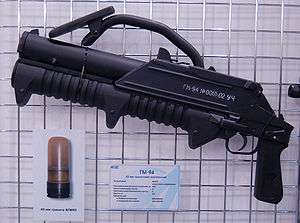Mongolian Ground Force
The Ground Force of Mongolia (Mongolian: Монгол Улсын Зэвсэгт хүчний Хуурай замын цэрэг, Mongol Ulsyn Zevsegt hüchniy Huurai zamyn tsereg, lit. 'Mongolian Land Force of the Armed Forces') is the land force of the Mongolian Armed Forces, formed from parts of the former Mongolian People's Army in 1992. It was known as the "Mongolian General Purpose Force" (Mongolian: Монгол Улсын Ерөнхий Цэргийн Хүчин) until 2016.
| Mongolian Ground Force | |
|---|---|
| Монгол Улсын Зэвсэгт хүчний Хуурай замын цэрэг | |
 The Mongolian Ground Force's emblem | |
| Founded | 1921 |
| Country | |
| Type | Army |
| Size | 30,000 active personnel[1] |
| Part of | |
| March | "The Red Banner March" (Тугийн марш/Tugiin Marsh) |
| Engagements | Mongolian Revolution of 1921 Soviet-Japanese Border War Soviet invasion of Manchuria Battle of Baitag Bogd |
| Commanders | |
| Commander | Brigadier General B. Amgalanbaatar |
| Chief of Staff | Brigadier General L.Ontsgoibayar[2] |
| Insignia | |
| Flag |  |
History
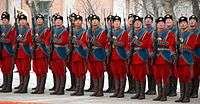

At present Mongolia's armed forces have become more compact and professional since obligatory military service was replaced with the alternative between military and other service. The ground force, a core of the armed forces, are the main force to defend the country by military means. In peacetime, the ground force direct their activities toward ensuring the mobilization readiness of the Mongolian Armed Forces, providing military training for the population, forming personnel resources, and organizing the maintenance, protection and servicing of military equipment and material reserves. Depending on the organizational specifics of military units and organizations, the ground force are divided into combat, on-combat-duty, training, training combat, and stockpile and service units.
As a result of reform processes started in 1997, units of the Mongolian Armed Forces were reorganized into a brigade-battalion system. In peacetime, sub-units of brigades have a mixed personnel organization (i.e. of constant combat readiness, training, and under strength). In 2016, the General Purpose Force was renamed to its current name of Ground Force of the Armed Forces.
The 016 Mechanised Brigade has been reported as the oldest formation of the Mongolian army, stationed at Sergelen near Ulaanbaatar.[3]
In 1997 the Mongolian Armed Forces had in service 650 tanks, 120 light armored reconnaissance vehicles, 400 armored infantry fighting vehicles, 300 armored personnel carriers, 300 towed artillery, 130 multiple rocket launchers, 140 mortars, and 200 anti-tank guns.
Mongolia deployed its troops to peacekeeping operations in Iraq and Afghanistan with 1970s Soviet-bloc weapons, transportation, and equipment. Although Mongolian troops are highly skilled with using these weapons and equipment, they are not interoperable with the rest of the coalition members. Except for the United States-provided Harris Corporation communications equipment, Mongolia had no other equipment which was interoperable.
From January 14 to 18 in 2008, Chief of the General Staff of the MAF Lieutenant General Tsevegsuren Togoo signed an agreement for acquisition of equipment and vehicles from Russia for 120 million US dollars during his official visit to Moscow, Russia.
Peacekeeping missions
.jpg)
Mongolian armed forces are performing peacekeeping missions in South Sudan, Sierra Leone, Ethiopia, Congo, Eritrea, Western Sahara, and Afghanistan, and with the United Nations Mission in Liberia. In 2005 and 2006, Mongolian troops also served as part of the Belgian KFOR contingent in Kosovo. From 2009 the Mongolian Armed Forces deploying its largest peace keeping mission to Chad and the government is planning to deploy its first fully self-sufficient UN mission there in mid-2011.
Equipment

.jpg)
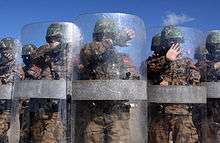
The Ground Force possesses over 470 tanks, 650 infantry fighting vehicles and armored personnel carriers, 500 mobile anti-aircraft weapons, more than 700 artillery and mortar and other military equipment. Most of them are old Soviet Union-made models designed between the late 1950s to early 1980s; there are a smaller number of newer models designed in post-Soviet Russia.
| Name | Origin | Type | Quantity | Notes |
|---|---|---|---|---|
| Tanks | ||||
| T-54/55 | Main battle tank | 370[4] | ||
| T-72 | 100[5] | |||
| Infantry fighting vehicles | ||||
| BMP-1 | Infantry fighting vehicle | 310[4] | ||
| BMP-2 | Infantry fighting vehicle | 100 | ||
| Armored cars | ||||
| BRDM-2 | Amphibious armored scout car | 120[4] | ||
| Armored personnel carriers | ||||
| BTR-60 | Armored personnel carrier | 150[4][5] | Most of them are BTR-60PBs. | |
| BTR-70 | 50[6] | |||
| BTR-80[7] | 20[5] | |||
| Multiple rocket launchers | ||||
| BM-21 Grad | 122 mm multiple rocket launcher | 130[4] | ||
| Towed artillery | ||||
| D-30 D-44 M-30 M-46 ML-20 | 122 mm howitzer 85 mm divisional gun 122 mm howitzer 130 mm towed field gun 152 mm howitzer gun | 300[4] | ||
| Mortars | ||||
| BM-37 PM-43 M-160 | 82 mm caliber mortar 120 mm caliber smoothbore mortar 160 mm divisional mortar | 140[4] | ||
| Anti-tank gun | ||||
| SPG-9 D-48 BS-3 T-12 | 73 mm anti-tank gun 85 mm anti-tank gun 100 mm field gun 100 mm anti-tank gun | 200[4] | ||
Infantry weapons
References
- The Military Balance 2013
- https://www.gsmaf.gov.mn/hztsk/commander
- "The Mongolian army was T-72 tanks and BTR-70M". Encyclopedia of safety. Retrieved June 20, 2016.
- The Military Balance 2012, p.267.
- "SIPRI Arms Transfers Database". Stockholm International Peace Research Institute. Retrieved June 20, 2016.
- http://armstrade.sipri.org/armstrade/page/trade_register.php
- "БХ-ын сайд тайлангаа тавив". News.mn (in Mongolian). May 3, 2011. Retrieved June 20, 2016.
- Jones, Richard D., ed. (January 27, 2009). Jane's Infantry Weapons 2009/2010 (35th ed.). Jane's Information Group. ISBN 978-0-7106-2869-5.
- "084.jpg". ImageShack.us. Retrieved June 20, 2016.
- Тусгай Хүчин (December 28, 2013). "Mongolian 084th Special Task Battalion". Retrieved June 20, 2016 – via YouTube.
- "Untitled JPEG". U.S Department of Defense. January 2004. Archived from the original on October 11, 2014. Retrieved 20 June 2016.
- "SVD rifles in use in Europe". Dragunov.net. Archived from the original on November 9, 2012. Retrieved June 20, 2016.
- "Untitled JPEG". ImageShack.us. Archived from the original on July 2, 2014. Retrieved June 20, 2016.

- World aircraft information files Bright Star Publishing London File 332 Sheet 3
External links
| Wikimedia Commons has media related to Military of Mongolia. |


